| 1 | Earth’s most iridescent snake |
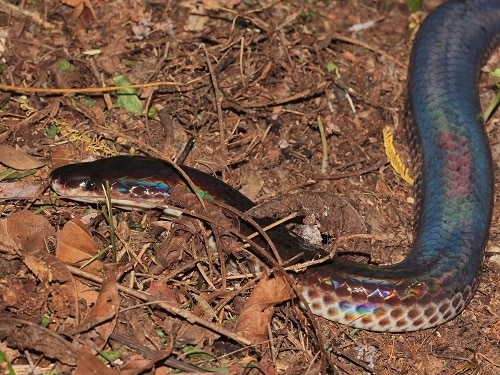
The sunbeam snake lives in Thailand and nearby southeast Asia, is fairly common, and has been studied by European scientists since the 19th century. Where it stands out from the snake pack is in its amazingly colourful scales.
In dull light, there’s nothing to write home about. The sunbeam snake has chocolatey brown scales, sometimes surrounded by white on either side, with occasional larger white patches on its body. The magic happens in the glare of light or sun. Sunbeam snakes have iridescent scales, and when the light intensity crosses a moderate threshold, these scales suddenly sprout every colour of the rainbow. They produce fluid, ever-changing patterns of red, blue, purple, yellow and green, with a constant iridescent undercurrent of violet-grey.
Sunbeam snakes have been called a living hologram, the effect is so weird when up close and personal. According to a 1955 study, the colours only reveal themselves when living; dead sunbeam snakes stored in alcohol revert back to grey or chocolatey brown no matter how much light you shine on them.
| 2 | Smooth and rubbery |

Another special feature of the sunbeam snake is being incredibly smooth. Their scales aren’t keeled in the slightest, unlike the red-necked keelback living nearby. Sunbeam snakes are so smooth that when you throw dirt over their backs, not one granule will stick.
This has a simple explanation: xenopeltis unicolor is a burrowing snake, not fully underground, but regularly digging channels 30cm deep in soft soil to rest in. Its head is also narrow and pointy to move through soil effortlessly, the opposite of a triangular cobra head (a good way to distinguish from the vicious monocled cobra nearby). Their eyes are very beady and small, with jet black pupils that seem to cover most of their eyes. This makes them very friendly looking, like a cartoon character.
According to this Thai snake expert, sunbeam snake scales have the texture of rubber. Sunbeam snakes average at 1 metre long – nowhere near enough to fully cross a Thai road, but maybe a footpath. The longest reach 1.25 metres.
Young sunbeam snakes have the exact same colour scheme as adults, except for a white collar below the head. There’s more white between the scales as well – the less white, the older the sunbeam snake.
| 3 | Safe to pick up |
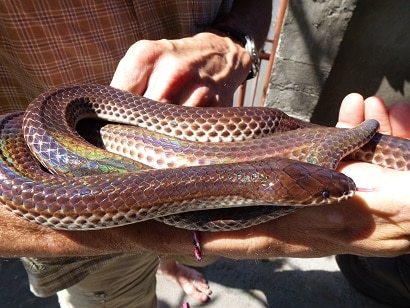
Your changes of dying from a sunbeam snake encounter are nil (unless you slip on it like a banana skin). There won’t be a flash of dazzling rainbow colour followed by a sharp pain of fangs all within milliseconds as you open your bathroom door. Sunbeam snakes lack any type of venom. They’re a constricting snake instead, and the most it will do is wrap 2 body lengths around your finger and squeeze tightly.
They almost never bite, even in self defence. According to a 1965 study: ” The serpent is a gentle creature seemingly unwilling to use its bite for defense”. They usually thrash around and try to escape the aggressor’s grip, and release a nasty smell, standard tricks in a snake’s repertoire.
They have one unusual trick though. An excited sunbeam snake sometimes coils its body up and vibrates its tail from side to side at high speeds, like a rattlesnake with no rattle, despite being nowhere close to them on the evolutionary tree. Malcolm Smith from 1943 called the vibrating so fast that it made a clearly audible sound.
| 4 | Hotspot: paths near rice fields |
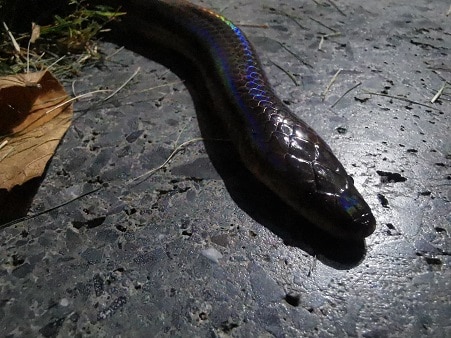
Starting from point 0, your house, where do you go in order to find a sunbeam snake? They’re a common yet elusive snake, but roads are a top place to find them. Their smooth scales are excellent for soil and mud, but make them extremely slow on hard surfaces such as tarmac and stone. It can taken xenopeltis unicolor an age to cross a road. They also stray into gardens, and can be found in parks, forest edges, and close to water bodies (but not in them).
Sunbeam snakes also gravitate towards agriculture, including rice paddies and guava plantations. A footpath cutting between two crop fields is a good spot, if you can brave the monocled cobras that might be lurking there too.
The killer is that sunbeam snakes are fossorial and love to stay under shelter. When not burrowing, they lurk under leaf litter or in mini lairs inside rotting logs. During bright sunny days, they’re almost never seen. Nighttime brings them out of shelter, as does rainfall. The hours immediately after monsoon rains are the optimal time to head for the roads and witness this snake’s mesmerizing colour.
| 5 | Inspired a cryptosnake |
Xenopeltis unicolor has the rare claim of spawning a fake snake, which everyone fruitlessly searched for like Bigfoot. It started in the Vietnam War in 1968, when two members of the US Naval Medical Research Unit were surveying jungles. The men spotted a thin, unusual snake which had the body shape of a burrower, and snapped 3 blurry pictures. Sadly, the specimen was lost in storage, but it didn’t stop a 1994 paper from declaring this to be an all new snake: Cryptophidion annamense, or the Vietnamese sharp-nosed snake. Crytophidion comes from the word cryptozoology – the search for animals whose existence is not yet proven.
Rainforests can hold endless secrets, and scientists quickly got on the hunt. The long lost Vu Quang ox was rediscovered in 1994, and a New York Times article mentioned the continuing search for the Vietnamese sharp-nosed snake. Nobody knew about its venom, nobody knew whether it could bite – they just knew it was out there.
But in 1996, the new terror vanished in a puff of smoke. Scientists re-examined the blurry photos and concluded that this bigfoot snake was just a sunbeam snake all along. Its head scales were identical, its eyes were similarly shaped, and its underbelly was equally pale. The phantom snake hasn’t made a comeback since.
| 6 | Primitive in evolution |
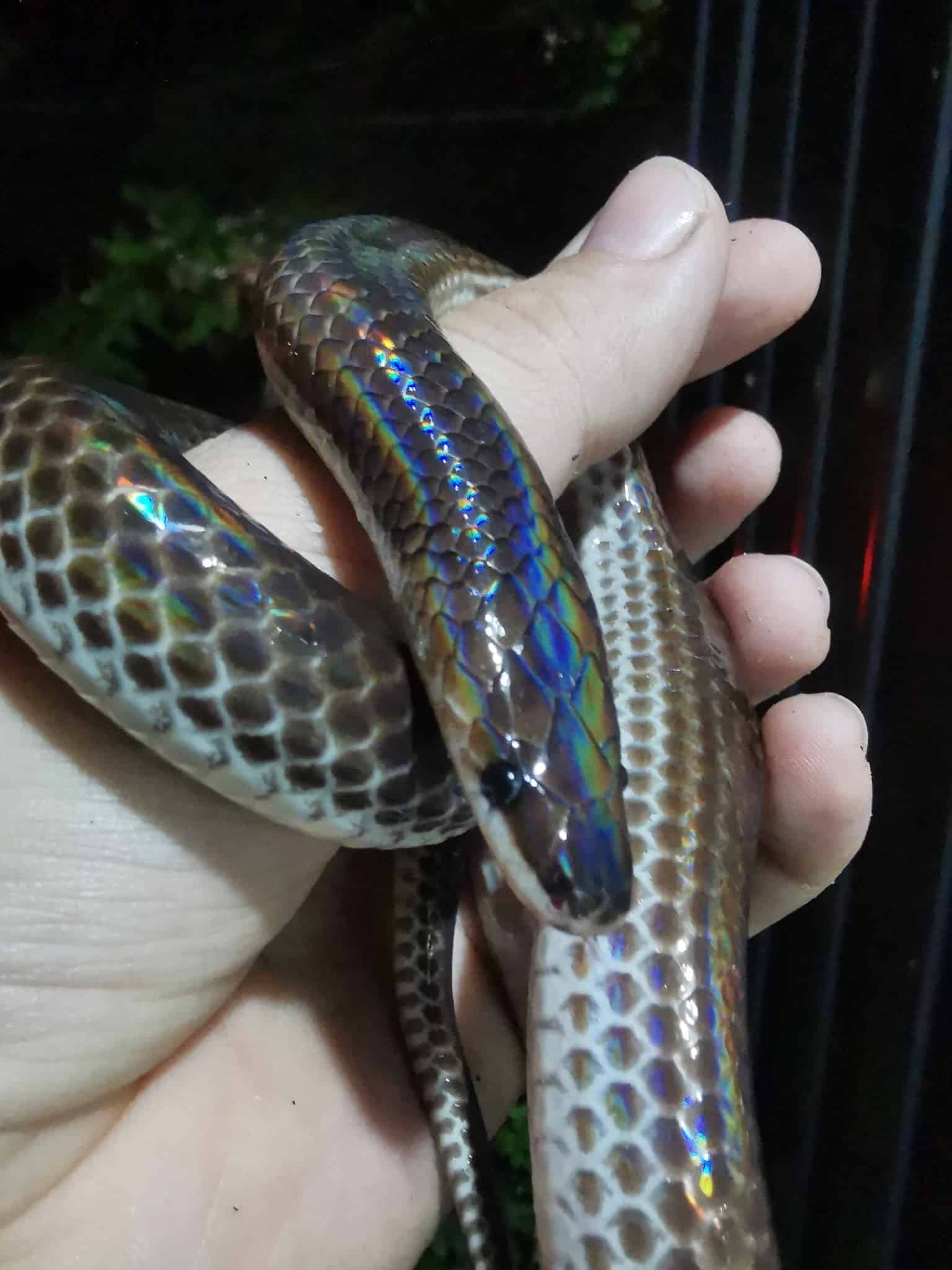
With its shimmering, spell-like colours, you might guess that the sunbeam snake is a superadvanced species, but it’s actually a very primitive snake. Its skull is much closer in shape to boas and pythons, some of the earliest snake families on the evolutionary tree. Look at its face head on, and there’s definitely a more ancient look to them, totally different to a more “evolved” cobra. Some theorise that their primitive skull structure prevents them from eating larger prey.
The sunbeam snake is very isolated: it’s the sole member of the xenopeltis family, except for the closely related Hainan sunbeam snake which lives in China and Vietnam. It has no close relations among living snakes, no nearby species it evolved from 10-20 million years ago.
The only theorised relative is the Mexican burrowing python, which lives halfway across the world, but has the most similarly structured skull. There’s also DNA similarities between the two, and of course the burrowing lifestyle. The epicentre of these snakes’ ranges lie approximately 9000 miles apart.
| 7 | Secrets of the past |
According to a 1914 report, the sunbeam snakes of old loved to hang out in Bangkok’s saw mills, lurking under the stacks of wood. Xenopeltis uniform constantly turned up in gardens, lurking beneath rubbish and heaps of leaves. In 1965, a scientist found one resting on a golf course in Prachuap Khiri Khan province, resting on a pile of grass.
Another report came from Phuket province in 1977, where sunbeam snakes were said to be extremely common at the time, being killed on roads regularly. But according to a 1955 report from east Java, they were much less common there, and in the Philippines in 1922, they were said to be very rare. Southeast Asia has clearly been their base all along.
Sunbeam snakes have had many names over the years. One Javan name was “ular ekor merak”, meaning like the tail of a peacock. On Sulawesi they called it the Earth snake, referring to its burrowing strategies. Then there’s the Latin name of xenopeltis unicolor. The latter part actually refers to its uniform chocolatey-brown colour rather than its magical flashiness. Xeno is used for countless species, but peltis means “strange skin”.
| 8 | Diet: a buffet snake |
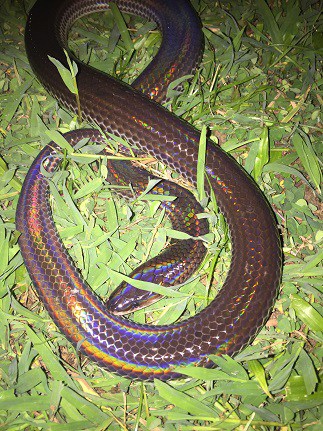
Sunbeam snakes have a particularly flexible diet, featuring small mammals, reptiles, and birds alike. Whether they have any favourite species is unknown. They also eat other snakes. In various records dotted around, they’ve been spotted eating a buff-striped keelback, rainbow snake, and streaked kukri snake,
In 1943, Robert Mertens reported how he placed a frog in a terrarium where a sunbeam snake was already living. The terrarium was filled with soil, and the snake had burrowed to the bottom, yet it instinctively sensed the frog’s arrival from its underground chamber. Within seconds the snake seized the frog, and ate it alive. Sunbeam snakes have finely tuned soil senses, and they can swallow prey extremely quickly if they want.
Other times they take longer: a later frog took 30 minutes to be constricted and swallowed. 5 minutes is about average, as a 2012 study monitored a Sphenomorphus lizard on Borneo Island in Indonesia. As it wandered past a rotting log, a waiting sunbeam snake pounced in an ambush, and wrapped two full body lengths around, beginning the constriction. The lizard died within 2 minutes, and after 5 minutes, it was fully swallowed. The sunbeam snake then withdrew to its rotting log lair, out of sight.
| 9 | Flexible hinged fangs |
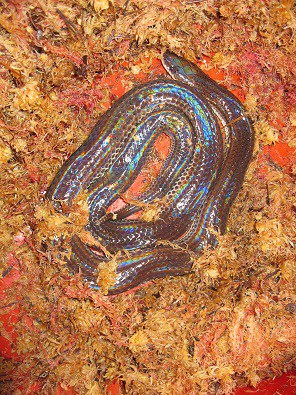
Another tale saw a sunbeam snake trying to swallow a Tokay gecko (gecko gecko). This is a staple meal of the golden tree snake, but the sunbeam snake struggled even to squeeze it to death. 45 minutes later, the gecko had almost freed itself from the coils. Just 1 leg remained inside, although it was exhausted. Another time, a sunbeam snake squeezed a large banded bullfrog for 10 minutes (on the island of Phi Phi Don), which just croaked repeatedly. When the observing scientists finally scooped up the snake, the frog was uninjured.
Another gimmick of the sunbeam snake is its hinged teeth. These have special sinewy connections to the upper jaw to increase flexibility, allowing them to grasp hard-bodied prey such as lizards. Imagine what would happen otherwise: their teeth could snap off as the lizard pushed back in the intensity of the struggle. Hinged teeth are already rare in snakes, but a 1981 study found that two styles exist: group 2, containing three different snake families, and hinged teeth group 1, which only contained sunbeam snakes. As ever, their skull is isolated from all others.
| 10 | Reports from captive keepers |
Some say that sunbeam snakes are extremely difficult to keep in captivity, often dying within a few days. But in 1993, a Thai snake expert reported that they’d been keeping a healthy sunbeam snake for 23 months. They had acquired the snake from Thai Red Cross, and it was still going strong.
The snake had shed its skin 14 times, once every 1.6 months on average. The owner was offering the sunbeam snake all sorts of meals, including mice (which it had eaten 30 times), guinea pigs (20), chickens (5), ducklings (4) and even one kitten.
On average, with all the choice in the world, the sunbeam snake was eating every 11.5 days. The owner noticed how it shied away from larger meals. The average prey was 18% of its body size, compared to a reticulated python he’d kept, which ate prey 80% its size. Bursting is a serious problem for snakes, and some are better at instinctively avoiding it (the four-lined snake is another that eats relatively small prey). The owner concluded that “This interesting, harmless and docile snake is ideal for the private collector just starting a collection of snakes“.
